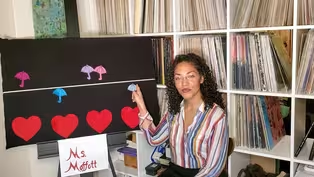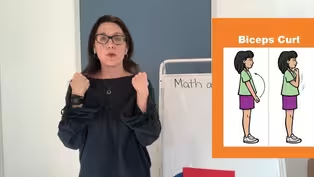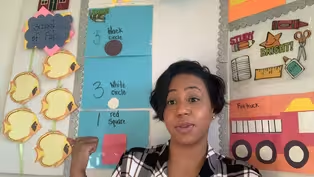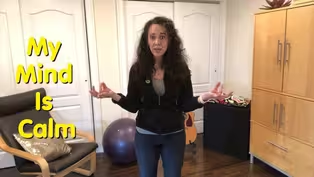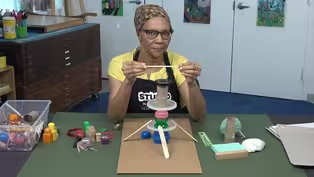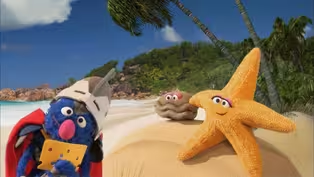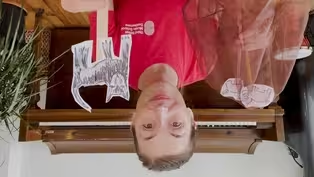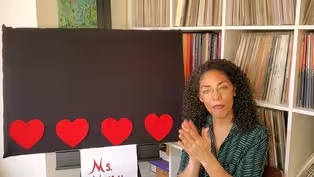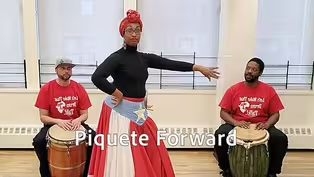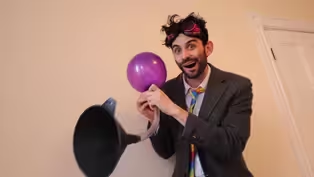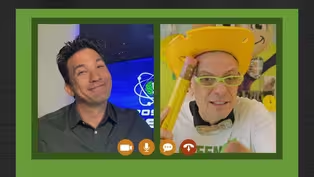
CL and AP Make CLAP!
2/24/2021 | 55m 57sVideo has Closed Captions
Learn about basic needs for animals, sing “Bell Horses,” read ASTRO GIRL.
Learn about basic needs for humans and other animals, sing “Bell Horses,” read ASTRO GIRL, explore the digraph ch. LET’S LEARN helps children ages 3-8 with at-home learning. One-hour programs feature instruction by educators and virtual field trips.
Problems playing video? | Closed Captioning Feedback
Problems playing video? | Closed Captioning Feedback
Let's Learn is a local public television program presented by THIRTEEN PBS

CL and AP Make CLAP!
2/24/2021 | 55m 57sVideo has Closed Captions
Learn about basic needs for humans and other animals, sing “Bell Horses,” read ASTRO GIRL, explore the digraph ch. LET’S LEARN helps children ages 3-8 with at-home learning. One-hour programs feature instruction by educators and virtual field trips.
Problems playing video? | Closed Captioning Feedback
How to Watch Let's Learn
Let's Learn is available to stream on pbs.org and the free PBS App, available on iPhone, Apple TV, Android TV, Android smartphones, Amazon Fire TV, Amazon Fire Tablet, Roku, Samsung Smart TV, and Vizio.
Providing Support for PBS.org
Learn Moreabout PBS online sponsorshipMore from This Collection
Video has Closed Captions
Read SCHOOL BUS and draw one, learn about prefixes and pitch, build sculptures. (57m 48s)
Running and Counting Both End in “ing”!
Video has Closed Captions
Move to improve, find the missing number, learn songs from Ghana, read ABUELITA’S SECRET. (58m 17s)
What Sound Does “aw” Make in Draw?
Video has Closed Captions
Read a story, discover "au" and "aw," learn about density, count, and move with music. (56m 58s)
Can You Find the Short “u” in Subtract?
Video has Closed Captions
Help Super Grover 2.0 solve a prickly problem, read ALL THE WAYS TO BE SMART. (56m 19s)
What Sound Does “gl” Make in Glove?
Video has Closed Captions
Play the glockenspiel, help Super Grover 2.0 make a cart move, read TWO WOOL GLOVES. (58m 9s)
Incredible Starts with Short “i”!
Video has Closed Captions
Solve problems with Super Grover 2.0, catch a rainbow, hear a piano sound like a cuckoo. (56m 9s)
What’s the Sound of “oo” in Book?
Video has Closed Captions
Explore animals’ form and function, sing about the 3 little pigs, read THE LITTLE BOX. (58m 15s)
We’re Reducing, Reusing and Recycling!
Video has Closed Captions
Learn all about rhythm and the number 9, read A BAG IN THE WIND. (56m 17s)
Video has Closed Captions
Learn to dance bomba and grow food in a city, read WOLF CUB’S SONG. (55m 20s)
How Many Syllables are in Invent?
Video has Closed Captions
Invent your own instrument, make 10 to add numbers to 20, read ONE GOLDEN RULE AT SCHOOL. (57m 36s)
Video has Closed Captions
Learn about the science behind mind reading, count shells, read MY BIG FAMILY. (57m 27s)
Which is Heavier: One Apple or Two Apples?
Video has Closed Captions
Defy gravity, learn secret code words for fast and slow in music, read WHOOO KNEW? (58m 5s)
Providing Support for PBS.org
Learn Moreabout PBS online sponsorship[ bright upbeat music] - [Narrator] Ready to learn?
- [Both] Hi!
- [Narrator] It's time to share a story, - Sh.
- Read and write.
- Let's read it back.
- Discover science.
- Sing.
♪ Some ♪ Play.
♪ Where ♪ [feet stomping] And so much more.
- Cupcakes - Very good.
- [Narrator] Stay tuned for lessons and activities.
- We're going to start making some words.
Isn't that fun?
[bright upbeat music continues] - [Narrator] Funding for this program was provided by the JPB Foundation.
- Hi everybody, my name is Maria.
- And I'm Miller.
- Miller.
And this is our sweet Hopper.
Hopper, say hi.
Oh my gosh.
Thank you, thank you for the paw.
Thank you for the paw Hopper.
So today we're going to read you a story- - And as well, Hopper will probably fall asleep.
- You think he'll fall asleep?
He was sleeping a second ago.
So let's see if he falls asleep.
- Maybe he goes to sleep.
- We'll see.
Maybe he'll really like the story.
We'll see.
So today we're going to read a book, and the name of the book is?
- "Astro Girl."
- "Astro Girl."
And it's written and illustrated by Ken- - Ken Wilson Max.
- Ken Wilson Max.
Thank you, Miller.
Okay, and lets read a little.
This section over here always tells you a little bit about the book.
So let's find out what the book's about.
"While mama is away, Papa and Astrid," and Astrid means?
Do you know what Astrid means?
Star.
"Have fun, acting out things, and astronaut does on a space mission.
Eating food from a package, sleeping far away from home, and doing experiments."
Okay.
So let's find out more about Astrid and her dad.
I think she wants to be an astronaut, don't you?
Okay, so let's get started.
And this is a picture of?
- [Miller] The night sky.
- The night sky- - Oh no space.
- The space too, right?
Okay, and this is her in a?
- Space suit.
- In a space suit.
- And a dog, is it?
- Yeah.
- And she has a dog.
- And she has a puppy.
And the dedication it says, "To my friend Coldep, and all the other girls who dream of exploring the stars."
So let's get started.
- [Miller] "Astrid had loved the stars in space, ever since she could remember."
- She had loved the stars in space ever since she could remember, maybe that are some of you, who liked to look out at the night sky, huh?
Maybe you loved the stars.
And look at her room.
It's very obvious, what do you notice, about her that showed that she loves the stars?
- [Miller] Because there's a bunch of space stuff.
There's an astronaut helmet and a plane.
- [Maria] Yeah and she has a globe over here.
Right?
- And the rocket ships.
- And the rocket ships, it looks like even the things in her room, shows that she's really interested with, in stars and space.
- [Miller] "I want to be an astronaut," Astrid told her best friend Jake, as they gazed up at the stars.
- [Maria] "Will you bring me an Asteroid when you come back from space?"
Asked Jake.
- [Miller] "Of course I will, Jakey."
- "Oh, that's so sweet."
So she's talking to her friends about her dreams.
What are your dreams?
What's what do you wanna be when you grow up?
- I wanna be an artist.
- You wanna be an artist?
What kind of artists?
- A graphic designer.
- Oh, like you dad, right?
So I wonder what you want to be when you grow up.
It's so much fun to talk about what you want to be when you grow up.
Okay.
"I want to be an astronaut," Astrid said at breakfast.
- "Are you sure Papa Ash?
You'll have to go round and round the earth in a spaceship."
- [Maria] He swung her around.
- "I can do that," Astrid said [indistinct] - I would love to read some Miller, okay?
"What about eating food out of a tube, or a package every day?"
Did you know that?
So when you are on a space shuttle and you're out of space, you can't cook.
I don't even think you can have a fridge, I'm not sure, but your food is in a tube, okay?
So it's very different to how we normally eat at home.
Actually astronauts have to be very healthy, okay?
They have to be physically healthy, physically strong.
They also know need to know how to swim well, okay?
And you also need to be really smart.
"I can do that," said Astrid as she munched on the cereal bite.
"Okay Astra girl, you'll also have to get used to zero gravity."
- [Miller] "Papa threw her up in the air."
- "I can do that all day long," Astrid laughed.
That's a strong dad.
[laughs] Can your dad still throw you in the air?
No.
"What about all the science experiments?"
Asked Poppa.
"Could you do those my brave explorer?"
- [Miller] "No problem," said Astrid, as they made rocket ship cookies.
- Oh so they're making, they look yummy, and what's this?
Is it little jelly?
I love cookies with jelly, yum yum.
"Will a space cadet like you, be able to sleep on your own among the stars?"
Papa us.
- [Miller] "I think that will be very hard, but I'll do it," Astrid whispered.
- I think she's falling asleep.
Also cool and cute they have cat and a dog.
"At last it was time to go get mama."
- [Miller] "Astrid wore her favorite space T-shirt."
- Oh that's lovely.
"At the space center, Astrid and her Papa moved to the front of the crowd, just as the doors opened."
And what do they see?
- People coming out.
- Yeah, they looked like astronauts, right?
You could see by the helmets they're holding.
And people seem very excited to see them but they're clapping, and they have cameras.
"Mama," Astrid gave her mama a big kiss.
"I missed you," said Astrid.
So who's her mom?
- [Miller] The astronaut.
- Yes, what a nice surprise.
I did not guess that her mom was an astronaut.
That's awesome.
So just like you wanna be a graphic designer, just like your dad, she wants to be an astronaut, just like her mom.
It's nice to have people around us, who are doing different interesting things 'cause then we'd want to do those interesting things too, right?
Okay.
So she has a great role model.
"I want to be an astronaut just like you," said Astrid.
"You are my hero."
Astrid has learned a lot about being an astronaut.
The word astronaut comes from the two Greek words.
Astron meaning" - [Miller] Star.
- [Maria] And nautes meaning?
- [Miller] Sailor.
- Okay.
So an astronauts is a star sailor.
Isn't that lovely?
"American astronauts, Neil Armstrong and Buzz Aldrin, were the first to land on the moon, in the Lunar Module Eagle, on July 20th, 1969."
Whose birthday is on July 20th?
- Dad.
- Yeah.
[laughs] "The first animal to go into orbit was a dog named Laika."
Oh my gosh, imagine how that, imagine if we sent hopper into space.
[laughs] I wonder how he'd like that.
You don't think he would?
- He's already asleep?
- Oh, I don't know.
- [Miller] Oh he's not there anymore.
- Oh no, he's gone, yeah he's gone.
Okay so, "The first animal to go into orbit was a dog named Laika, on the Russian Sputnik 2 spacecraft on November 3rd, 1957."
On this page, we learn a lot about some history about astronauts.
So let's learn some things.
"So Valentina Tereshkova, from Russia was the first woman in space in 1963."
Imagine being the first person to ever do something.
That must be really cool.
Won't you feel pretty special?
[laughs] Okay.
Now, "Shannon Lucid, from the United States, set an early record for the longest time in space by a woman."
She was in space for 188 days, that's a long time.
- In school we learn that, that somebody was in space for a year.
- Oh really?
Oh my goodness, that's a really long time, 'cause a year is 365 days- - And he changed.
- Oh, wow.
What do you mean?
- Like part of her body, he was strong but then he got weaker when he came back.
- Oh really?
Wow.
So he has to do a lot of exercise when he came back.
- Yeah and he lost his balance.
- Yeah, because there's no gravity in space.
Wow, I'd love to learn more about that.
They also tell us about Dr. Jemison.
And she was the first African-American woman to go to space in 1992, okay?
And then Kalpana Chawa, was the first woman born in India to go to space in 1997.
- [Miller] "Space food is freeze-dried so that it won't spill and cause any damage to machines.
Fruit, bread and nuts are okay as they are."
- That is awesome.
So I wanna teach you something.
Could you wanna learn something?
I learned, can you hold this for me Miller, 'cause I wanna make sure I remember it.
I learned a very cool way, to remember some planets in the solar system.
Do you wanna learn it with me?
Okay, you're ready?
Okay.
So repeat after me.
Okay.
You ready?
My.
- My.
- Very.
- Very.
- Excellent.
- Excellent.
- Mother.
- Mother.
- Just.
- Just.
- Served.
- Served.
- Us.
- Us.
- Nine.
- Nine.
- Pizzas.
Now say it with me.
My.
- My.
Very.
- Very.
Excellent.
- Excellent.
Mother.
- Mother.
Just.
- Just.
Served.
- Served.
Us.
- Us.
Nine.
- Nine.
Pizzas.
- Pizzas.
Now, we're going to take the first letter of each word, and it's going to help us remember the planet.
So my is?
Mercury.
V is?
Venus.
- Venus.
- E is?
Earth.
- Earth.
- M is?
Mars.
- Mars.
- J is?
Jupiter.
- Jupiter.
- S is?
Saturn.
- Saturn.
- U is?
Uranus.
- Uranus.
- N is?
Neptune.
- Neptune.
And P is?
Pluto.
- Pluto.
My very excellent mother just served us Nine Pizzas - Nine pizzas.
- So it's Mercury, Venus, Earth, Mars, Jupiter.
- Jupiter.
Saturn.
- Saturn.
Uranus.
- Uranus.
Neptune and?
Pluto.
- Pluto.
- Thank you for reading this story with us.
And I hope you have a wonderful day.
Bye.
- Bye.
- Hi movers and shakers, this is Violet.
It's time to do little singing and moving.
I really like this song 'cause it's about ants, which are little bugs that sometimes crawl into your apartment.
For this song we're going to match.
So you can march in your seat like this.
You can stand up and match, or you can keep the time on your lap.
♪ The ants go marching one by one ♪ ♪ Hurrah hurrah ♪ ♪ The ants go marching one by one ♪ ♪ Hurrah hurrah ♪ ♪ The ants go marching one by one ♪ ♪ The little ones stops to suck his thumb ♪ ♪ And they all go marching down ♪ ♪ To the ground ♪ ♪ To get out ♪ ♪ Of the rain ♪ ♪ The ants go marching two by two ♪ ♪ Hurrah hurrah ♪ ♪ The ants go marching two by two ♪ ♪ Hurrah hurrah ♪ ♪ The ants go marching two by two ♪ ♪ The little ones stops to tie his shoe ♪ ♪ And they all go marching down ♪ ♪ To the ground ♪ ♪ To get out ♪ ♪ Of the rain ♪ Thanks for singing with me.
[bright upbeat music] - Well hello again friends.
My name is Renata, and we're gonna have a blast today.
The first thing we're gonna do, is alliteration, which means we can listen and notice the same sound in the beginning of different words.
The next thing we're gonna do is, blend to say, read and write words, and we're gonna pay special attention to the sound ch and the spelling C H, let's get started.
Okay learners.
Our first activity will be alliteration, where we listen and notice the same sound in the beginning of words.
Listen to these words, hawk, horse.
The first sound is H. We're gonna be listening for the sound H, also for the sound K, and for the sound CH, in the beginning of words.
Repeat these words after me, and then say the first sound that you hear in those words.
Here we go.
Chat.
Chin.
Yes.
The first sound is CH.
How about these two?
Cain.
Cart.
Yes.
The first sound K. Repeat these words.
Hand.
Heart.
Yes.
You can hear H in the beginning of those words.
How about, Chair.
Cheer.
Yes.
You could hear CH in the beginning.
Can you think of another word that begins with the sound K?
Tell me.
Excellent.
What about the sound H?
Yes.
How about that other sound CH?
Nice work learners.
You practice listening for the same sound in the beginning of words, and you even thought of someone your own.
Let's keep it moving.
Okay learners.
We're gonna play a quick fun game where you crack the code of a mystery word that I'm gonna say in a sentence.
Listen.
The CH I K hatched from an egg.
I said CH I K. Chick is the word, and the sentence is, the chick hatched from an egg.
You ready for your turn?
All right, listen closely.
Dan can H O P E to win the game.
Yes.
Hope is the word.
The sentences is, Dan can hope to win the game.
Here's another.
Will you be B A K in school tomorrow?
Yes.
The word is back.
The sentence is, will you be back in school tomorrow?
Here's another.
Grace has a cut on her CH I N. Yes.
Chin is the word.
Grace has a cut on her chin.
Here comes another.
I know the N E I M Z of many animals.
Yes.
Names.
I know the names of many animals.
One more.
Here we go.
It was kind of you to bring a G I F T. Oh, you got it.
Gift.
It was kind of you to bring a gift.
Nice work learners.
Okay my friends we're gonna play another fun game with sounds.
In this game, you're gonna change the beginning sound in a word, to a new sound.
Watch how I practice.
Here's a word, rip.
The first sound is, R. I wanna change that sound to CH.
Listen.
R IP, CH IP, chip, chip is the new word.
Do you think you can do it?
I know you can.
Try with these words.
Change the sound L in lunch to PU.
Yes.
The new word is punch.
Change the sound SH in shop to CH.
Yes.
Chop is the new word.
Change the sound R in reach to T. Yes.
The new word is teach.
Last one.
Change the sound H in hat to CH.
You got it.
The new word is chat.
That wasn't easy.
Excellent work friends.
Well learners, we've gotten to the part of our lesson where we're gonna practice reading and then writing.
We've been working with a sound CH during this lesson.
And I wanna show you how to spell using that sound.
When you have the letter C by itself, it makes its own sound.
When you have the letter H by itself, it has its own sound.
But when you put these two letters together, they make a new sound.
And this kind of sound we call a diagraph, which means two letters that make one sound.
This diagraph C H represents the sound CH.
Can you make that sound?
Nice.
Let's build some words with this sound, and blend to read them.
Here we go.
I have a word here for us.
Let's go.
CH I N. CHI N. Chin.
Let's see if I can change that word for us, to read another one.
How about CH I P. CHI P. Chip.
Ooh, let's see.
How about a different vowel in the middle?
CH O P. CHO P. Chop is the word.
I think we're ready to read more words.
Okay learners, we're gonna blend and read a few words and sentences.
Follow me.
CH I P. CHI P. Chip.
CH I N. CHI N. Chin.
CH O P. CHO P. Chop.
We'll go a little quicker now.
CH A T. Chat.
CH ILL. Chill.
CH I M P. Chimp.
Now notice the diagraph is at the end of the word.
S U CH.
Such.
M U CH.
Much.
R I CH.
Rich.
Now let's read two sentences together.
CH I K. Chick, and D U K, duck, like CH E S, chess.
This sentence is, chick and duck like chess.
Next sentence.
Chick S ELS, sells duck D IP, dip and J AM, jam.
The sentence is, chick sells duck dip and jam.
Nice work, blending and reading friends.
Okay learners.
Let's use what we know, to blend and write a few words with this diagraph.
We'll use our colored tiles to top the sounds, and then you'll help me write.
Here we go.
First word.
Say, chop.
Make the sounds CH O P. Let's write.
CH are two letters that make one sound, O P. There we are, chop.
Next word say chip.
Make the sounds CH I P. Let's write, CH I P. Excellent.
Next word.
Say chin.
CH I N. Here we go.
CH I N. Let's see if we can write a few words that have the diagraph sound at the end.
Say much.
M U CH.
M U CH.
Next word, rich.
R I CH.
R I CH.
Great.
Last word.
Such.
S U CH.
S U CH.
Nice work.
We just spelled, chop, chip, chin, much, rich, and, such.
Nice work practicing spelling with this diagraph C H CH.
Well learners, we've reached the end of our really fun lesson.
You did an amazing job today.
You practice alliteration, listening for the same sound in the beginning of words.
You also blended to say, read and write different words, and you practiced working with the diagraph C H, that sound CH.
Continue practicing all these activities with a trusted adult at home.
Until next time, have a wonderful day.
[light melodic music] - My name is Liz, and my husband Dave and I have four beautiful kids.
John and Jordan are both on the autism spectrum.
With autism you have your set of challenges.
But we believe that their brain works in a beautiful way.
Children on the spectrum can become fixated on a particular topic or special interests.
John love building structures, lately Jordans's passion has been baking.
We like to use their interests to help motivate them.
Do you wanna bake cupcakes?
But we can't make a cupcake until we do this homework.
John and Jordan both struggle with multi-step directions.
The chart really does help them understand what they need to do next.
The whole process of baking, has so many wonderful advantages.
It helps support reading and mathematics.
- You having?
- [All] 12.
- [Liz Voiceover] Living into their interests has been a great motivator for the boys.
It's helped them with their self-esteem, and their independence, but it's also been a great way for us to bond as a family.
[gentle music] [bright upbeat music] - Hello there, welcome to the Memphis zoo here in Memphis, Tennessee.
My name is Max, and I'm an animal interpreter here at the Memphis zoo.
As an animal interpreter, my job consists of two things.
Number one, getting to teach people, just like you at home, about how amazing and important animals are.
And number two, I'm a keeper for our ambassador animals.
And ambassador animals, are animals that are comfortable coming out to meet people, like Creamsicle, the rat snake here.
Other keepers take care of animals that live in habitats all over the zoo, like giant pandas or our African elephants.
Now there's a lot of animals here at the zoo that depend on their keepers to keep them happy and healthy.
And one of the ways that we do that is by making sure their basic needs are met.
A basic need is something an animal must have, to stay alive and to be comfortable.
So take a moment to think about what an animal may need to be able to live.
Any ideas?
Well, what if I told you that the basic needs of animals and people are exactly the same?
So think about what you may need to live, and see if that might work for an animal.
And while you're thinking about it, I'm gonna head inside where we can talk more about the basic needs of animals and people.
And while we're in there we may also get to meet some more animals.
So come on in.
[gentle music] Welcome to our outdoor classroom.
Now that you've had some time to think about it, we're gonna be discussing the basic needs of ourselves and our animals.
But to start, I'll give you a hint.
There are four of them.
Now, if you're currently eating anything, or feeling a little bit hungry like myself, eating breakfast, actually helps to fulfill our first basic need, food.
Now, food is as important to animals as it is to you and I.
They need it to be able to live and thrive.
But not all animals eat the same thing.
Just like how your breakfast may be different from your neighbors or your friends.
Some animals only eat a specific type of food.
For example, carnivores like a tiger, only eats meat, and then herbivores like a cow only eats plants, and then omnivores eat meat and plants.
A lot of people I know are omnivores, but what kind of eater are you?
[gentle music continues] Now, animals need a certain amount of food depending on their size and their age.
Take for example, Poppy the binturong here.
Poppy is one year old.
So she needs plenty of food to grow nice and big when she's an adult.
Dexter the short tail possum is also an omnivore, but he is much smaller than Poppy and he's fully grown.
So the amount of food he gets is going to be appropriate for his size.
Smaller amount of food, for his smaller size.
Just like it's important for us to eat a balanced diet, it is important for animals as well.
At the zoo, we ensure our animals are having all of their nutritional needs met, through their diet so that they can be healthy.
But of course, that doesn't mean they don't enjoy their occasional treat or have a favorite food.
Poppy's absolute favorites are grapes.
Dexter loves apple sauce.
I love my spaghetti and salad, but I also like ice cream too.
Now all this talk about food has me feeling very thirsty, which brings us to our second basic need, water.
And water is just as crucial to animals as it is to people.
So while something like an elephant may need a lot more water than an animal like a mouse, they both need water to survive.
Now, people can drink water using their mouths, but animals like, say for example Griz the Virginia possum, laps the water using her tongue up into her mouth, just like a dog.
Can you think of any other ways an animal might drink water?
Did you know that amphibians like frogs and toads, don't use their mouth like the opossum, they actually soak water up through their skin.
No matter the method in which animals get their water, it's important that they are getting clean water.
We provide our animals with fresh water every day, so that they're always able to fulfill that basic need.
Now that we've been fed and have had plenty to drink, it's time to learn about our third basic need.
Shelter.
Shelter is where an animal chooses to live, that helps to keep them safe from weather, and sometimes other animals.
It's basically an animal's home.
And where an animal chooses to make shelter, depends on their lifestyle.
Take for example, Val the Mexican burrowing Python.
Snakes like Val, like to live under a rock or make tunnels in the dirt.
And that's because, they spend most of their lives on the ground.
Barn owls, like to find shelter in a tree hollow, because they spend their time in the branches of the forest.
Depending on the season, animals may have different reasons for the shelter they choose.
During the summer, a bird like a barn owl, may look for a tree with lots of shade to keep them cool.
During the winter, a reptile like Val, may find a nice burrow underground to stay nice and warm.
When it's warm or cold outside, what kind of shelter would you look for?
[gentle music continues] Our last basic need is space.
And animals need plenty of space from each other, as well as space just to be able to move around.
And the amount of space that an animal needs, depends on their size and their behavior.
Take for example, Aggie, the Nigerian dwarf goat.
Aggie likes plenty of space to be able to go on walks, and also to explore.
A smaller animal like Bandit the bull snake, needs enough space to be able to stretch out, and dig in the soil.
Our goats like to be able to walk and jump, so we like to give them space where they have things to climb on.
Our snake Bandits, slithers on the ground, and likes to stay hidden in the grass.
What about you?
How do you like to move?
What kind of space would you need?
Well, my friends, we have reached the end of our lesson.
So let's review what we learned today.
We talked about the four basic needs that people and animals need to stay alive.
Do you remember what they are?
Take a moment to think about it.
[gentle music continues] The four basic needs are number one, food, number two, water, number three, shelter, and number four, space.
You may be wondering, if you can help provide these basic needs for any animals that live around your home.
If you have any pets, you're probably already helping to provide for their basic needs.
If you wanna help wild animals, you need to remember one thing.
It's one of the basic needs that we listed.
Can you think of it?
[gentle music continues] That's right.
We have to give wild animals, plenty of space.
Because they're not comfortable around people.
For animals here at the zoo, they spend every single day working with us, so it's okay for them to be around us.
But wild animals don't know you that well.
So we have to give them plenty of space so we don't scare them.
There are still plenty of other ways to help.
For example, you can help provide shelter for animals.
You can build a bird house or a bat box.
You can also make a pond for amphibians like toads.
Even planting trees and bushes, can help provide shelter and food for a lot of smaller animals.
And those are just a few ways that you can help animals living in your home and in the wild.
Remember, we share home animals of all different types and sizes.
The more we can learn about these animals, the better we can help each other.
Well, I think that's gonna do it for us here at the Memphis zoo.
Thank you so much for coming to visit us today.
I hope you all have a wonderful rest of the day, and we'll see you next time.
[gentle melodic music] [Woman speaking in foreign language] [bright upbeat music] [guitar strumming] ♪ You'll sing a song and I'll sing a song ♪ ♪ And we'll sing a song together ♪ ♪ You'll sing a song and I'll sing a song ♪ ♪ Through warm or wintry weather ♪ ♪ You'll tap the tune and I'll tap the tune ♪ ♪ And we'll tap the tune together ♪ ♪ You'll tap a tune and I'll tap a tune ♪ ♪ Through warm or wintry weather ♪ [guitar strumming] ♪ You'll whistle a while and I'll whistle a while ♪ ♪ And we'll whistle a while together ♪ ♪ You'll whistle a while and I'll whistle a while ♪ ♪ Through warm or wintry weather ♪ Are you ready to whistle?
Let's try it.
[Jennifer whistling] [guitar strumming] Let's sing it together one more time.
♪ You'll sing a song and I'll sing a song ♪ ♪ And we'll sing a song together ♪ ♪ You'll sing a song and I'll sing a song ♪ ♪ Through warm or wintry weather ♪ Hi everyone, my name is Jennifer and I teach music at Third Street Music School.
Thank you so much for staying with me just now.
I'm so excited to get started.
We're gonna sing, play instruments, and learn all about rhythm in today's music segment.
The song we just sung was called, "You'll sing a song and I'll sing a song," by Ella Jenkins.
It's one of my favorites to sing, because there's so many different ways we can play and sing along with it.
Today for example, we sang with our voices.
We tapped, and we whistled.
But if you're singing this song at home, you can hum, stump, or tap along with the rhythm.
The next one we're gonna learn, is the song, "Bell horses."
And we can sing the song using really simple rhythms.
You might not know this, but a lot of our favorite songs can be broken down into really simple rhythms, that we can sing or via an instrument.
So let's get started.
I'll sing a little bit, I wanna see if you can be my echo.
Can you copy what I sing?
Let's try it.
♪ Bell horses, bell horses ♪ ♪ What's the time of day ♪ Your turn.
♪ Bell horses, bell horses ♪ ♪ What's the time of day ♪ ♪ One o'clock, two o'clock ♪ ♪ Time to eat some hay ♪ Your turn.
♪ Time to eat some hay ♪ Horses love hay, can you pick up a big bale of hay?
And take a couple of crunches out of it?
Delicious.
Let's keep singing.
♪ Bell horses, bell horses ♪ ♪ What's the time of day ♪ Your turn.
♪ Bell horses, bell horses ♪ ♪ What's the time of day ♪ ♪ Three o'clock, four o'clock ♪ ♪ Time to run away ♪ Now, hold on a second.
Do horses run like humans?
No.
Horses gallop.
Let's see what it sounds like when humans walk and run, and what it sounds like when a horses gallop.
Can you play the same rhythm with me on your lap?
When humans walk, we make a rhythm like this.
Walk, walk, walk, walk.
Now when humans run, it's a little bit faster, right?
Running, running, running, running.
Now when horses move really fast they gallop, and that makes a totally different rhythm.
Can you try and play along with me?
Padam padam padam padam, gallop, gallop, gallop, gallop.
Nice.
At the end of our song, "Bell horses," sometimes I like to get up and gallop around like a horse.
If you can do that safely in your home give it a try.
♪ Pananam pananam pananam pampam ♪ ♪ Pananam pananam pananam pampam ♪ ♪ Pananam pananam pananam pampam ♪ ♪ Pan pananampampam ♪ All right, come on back.
This time when we sing "Bell horses," let's add the rhythm by tapping our laps.
Can you keep being my echo, and sing and tap how I sing and tap?
♪ Bell horses, bell horses ♪ Your turn.
♪ What's the time of day ♪ Your turn.
Nice.
Now, one way we can figure out this rhythm, is by figuring out how many sounds they are in each word.
Let's see if we can break it down together.
♪ Bell ♪ That was just one sound.
♪ Horses ♪ Two sounds.
♪ Bell ♪ ♪ Horses ♪ Now, it gets a little trickier.
♪ What's the time of day ♪ Can you clap or count along with me?
♪ What's the time of day ♪ Five sounds.
You know what, I bet we could show these rhythms, on a piece of paper or a whiteboard.
I've got one here with me.
Can we sing along with the words, as I point to them on my whiteboard?
♪ Bell horses, bell horses ♪ ♪ What's the time of day ♪ Now in music, we use symbols or notation, to keep track of the rhythm.
Let's add it into our song lyrics together.
We had said that bell had one sound so, we can put one line.
Now for horses, how many sounds did we say that one had?
Two, wasn't that two sounds?
One, two.
I'm gonna go ahead and fill in the rest 'cause it repeats itself.
Bell horses.
Now for the bottom line, we said there was five sounds.
♪ What's ♪ ♪ The ♪ ♪ Time ♪ ♪ Of ♪ ♪ Day ♪ And there we have it.
That's the rhythm of our song, "Bell horses."
Will you sing along as I point out, the rhythm on my whiteboard?
♪ Bell horses, bell horses ♪ ♪ What's the time of day ♪ Nice sure, let's sing it one more time.
♪ Bell horses, bell horses ♪ ♪ What's the time of day ♪ Great job.
Now that we know the rhythm of our song, we can take the next step by adding some instruments along with it.
This is one of my favorite ways to sing "Bell horses."
We can find instruments from all over our homes.
For example, we could tap the rhythm on a bowl.
♪ Bell horses ♪ We could also find something in our homes to shake to make a sound.
For example, I've built my own shaker at home.
[item shaking] But you could use something like a box of cereal, or a container of rice to make the same sound.
♪ Bell horses ♪ Another way we could keep the rhythm to our song, is by tapping something together, like a pair of chopsticks.
♪ Bell horses ♪ Or you might have a pair of spoons in your house.
These almost sound a little bit like bells.
♪ Bell horses, bell horses ♪ Now, I'm lucky enough to actually have some bells in my house.
They look like this.
[bells jingle] I'm gonna use my bells to keep the rhythm of our song.
I'm gonna use my bells, you could use whatever you have at home, or you can just tap your lap.
Let's sing our song one last time altogether.
♪ Bell horses, bell horses ♪ ♪ What's the time of day ♪ ♪ One o'clock, two o'clock, time to eat some hay ♪ ♪ Bell horses, bell horses ♪ ♪ What's the time of day ♪ ♪ Three o'clock, four o'clock, time to run away.
♪ This is your last chance to gallop, go ahead.
♪ Pananam pananam pananam pampam ♪ ♪ Pananam pananam pananam pampam ♪ ♪ Pananam pananam pananam pampam ♪ ♪ Pan pananampampam ♪ That was so fun.
Thanks friends for singing and playing, "Bell horses" with me.
Can you believe it's already the end of my music segment?
Let's sing a goodbye song altogether.
I'm going to need your help in two different ways.
First, can you help me by clapping two times?
Easy enough.
The second one you can help me is by making a big alligator mouth with your arms, and snapping them shut, just like a big alligator's mouth.
Can you try that?
All right, friends.
I think we're ready to sing our goodbye song together.
It goes like this.
♪ We got to go now ♪ ♪ Bye-Bye we've got to go now ♪ ♪ Bye-Bye we got to go now ♪ ♪ Bye-Bye ♪ ♪ See you later ♪ ♪ Alligator ♪ ♪ See you later ♪ ♪ See you next time.
♪ Bye everyone.
[bright upbeat music] ♪ I draw myself the world with a box of crayons ♪ ♪ Yeah I draw myself the world with a box of crayons ♪ ♪ I start with blue to fill up the sky ♪ ♪ And I leave some white to make the clouds go by ♪ ♪ Yeah I draw myself the world with a box of crayons ♪ ♪ Ooh ♪ ♪ I draw myself a car with a purple crayon ♪ ♪ Yeah I draw myself a car with a purple crayon ♪ ♪ I draw a box with a seat inside ♪ ♪ And add four circles for the wheels to ride ♪ ♪ I draw myself a car with a purple crayon ♪ ♪ Ooh-Oh ♪ ♪ Ooh-Oh ♪ ♪ Ooh ♪ ♪ I draw a kangaroo with the brown crayon ♪ ♪ The big brown tail and a pouch that I hope to stay on ♪ ♪ I know exactly what she's trying to find ♪ ♪ So I take a green crayon and draw tiny lines ♪ ♪ Yeah I draw a field of grass for her to play on ♪ ♪ Ooh-Oh ♪ ♪ Ooh-Oh ♪ ♪ Ooh ♪ ♪ With my colors such beautiful colors ♪ ♪ Colors my favorite colors ♪ ♪ Yellow zigzag lightning fills the sky ♪ ♪ And cold Grey raindrops splash into my eyes ♪ ♪ I wanna keep my little friends from harm ♪ ♪ So I take a red crayon and draw us a barn ♪ ♪ Yeah I draw myself a barn with a red crayon ♪ ♪ And I draw myself a sun with a yellow crayon ♪ ♪ Just a circle with some lines to get it's ray on ♪ ♪ And suddenly a rainbow fills the air ♪ ♪ I can see all my favorite colors are shining there ♪ ♪ Yeah I draw myself a rainbow with all my crayons ♪ ♪ Ooh-Oh ♪ ♪ Ooh-Oh ♪ ♪ Ooh ♪ ♪ It's my colors ♪ ♪ Such beautiful colors ♪ ♪ All these colors ♪ ♪ My favorite colors ♪ ♪ With my colors ♪ ♪ Such beautiful colors ♪ ♪ All these colors ♪ ♪ My favorite colors ♪ ♪ Red colors ♪ ♪ Orange colors ♪ ♪ There's yellow colors ♪ ♪ Blue colors ♪ ♪ Green colors ♪ ♪ And indigo colors ♪ [bright upbeat music] - Hi, my name is Fabio.
And today we're here to talk about feelings.
But first, I want you to meet my friend, Piggy.
He will help us to understand what a feeling is.
Let me call him, Piggy?
Piggy?
- Here I am.
Hi friends, my name is Piggy.
- Hi Piggy.
How are you?
How do you feel today?
- I feel happy, do you know why?
- Why?
- Because I see lots of friends on TV.
- Yes, they are here because they want to learn about feelings.
Piggy, do you know what a feeling is?
- Yes.
Feelings are there reactions and sensations, that you have in your body when something happens.
- Oh, I see.
So that means that my body reacts differently with different feelings?
- That's right Fabio.
For example, how do you feel when you cannot go to the park, or when you cannot watch TV?
- Oh, I feel sad.
I like to go to the park to play with my friends.
- I can see it.
Your face is telling me that you're sad, because you have a frown.
The corners of your mouth are turning down, and your eyes are looking down.
Sometimes we can even get teary eyes, and cry, and our voice volume is low.
- Yes Piggy, you are right, and that makes sense.
That tells me when I'm feeling sad.
- But Fabio, do you know that feelings can change?
- No.
- Yes for example, how do you feel when you get your favorite treat?
Like an ice cream?
- Oh I feel happy especially when it's a chocolate ice cream.
I love chocolate ice cream.
- I see you're smiling, your face is telling me you're happy because you have a smile and I can see your teeth.
Sometimes we can jump, and our voice volume gets high.
- Okay.
Thank you Piggy for that explanation.
So friends, next time that something happens to you, pay attention to your body, because it will give you clues about how you are feeling, right Piggy?
- That's right.
- Okay I see.
So let me see if I understand.
So today we talk about two feelings, sad and happy.
When I feel sad, my eyes look down and I may cry.
Right Piggy?
- That's right.
Okay, but feelings change.
So when I feel happy, I smile and I may jump because I'm happy.
- You got it, great job.
- Thank you Piggy, thank you.
So let's see if our friends can make a happy face.
Everyone, smile.
- Smile, cheese.
- Piggy do you see that?
They're all smiling.
- They're all smiling, yeah.
Great job Fabio.
- Oh, thank you so much Piggy.
Thank you so much friends.
And I hope Piggy and I were able to help you recognize when you are feeling happy, and when you are feeling sad.
We will see you next time.
Bye-bye - Bye.
[bright upbeat music] - [Narrator] Funding for this program was provided by the JPB foundation.
[bright upbeat music continues] [light melodic music]
Support for PBS provided by:
Let's Learn is a local public television program presented by THIRTEEN PBS
